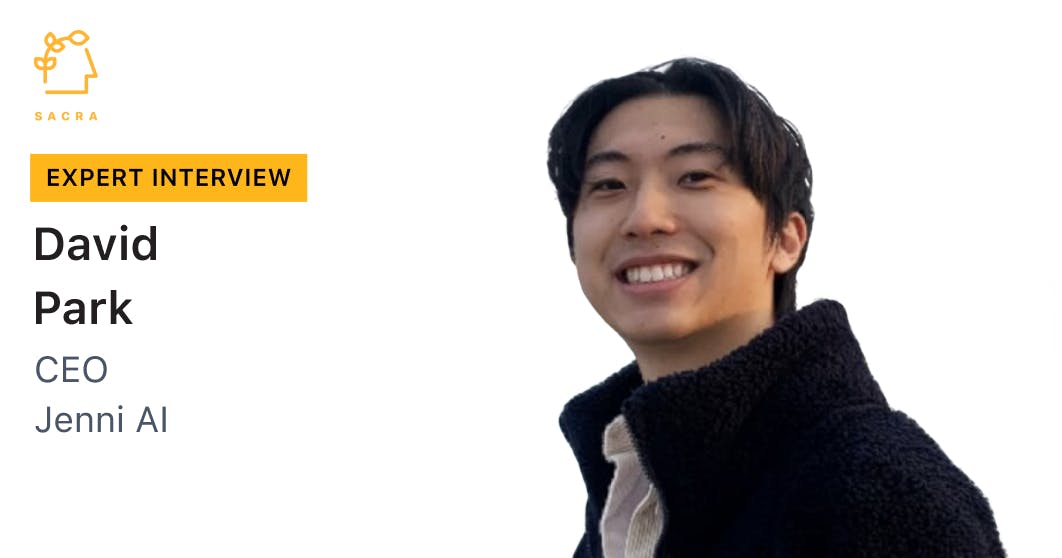David Park, CEO and co-founder of Jenni AI, on prosumer generative AI apps post-ChatGPT
 Jan-Erik Asplund
Jan-Erik Asplund

Background
David Park is co-founder and CEO of Jenni AI, a generative AI copilot for academic researchers. We talked to David about building prosumer generative AI applications after the "ChatGPT-pocalypse", Jenni AI's successful influencer marketing campaign, and how they niched down into the student essay-writing vertical.
Questions
- You’ve been working with GPT since GPT-2. What were the capabilities with GPT-2 and what potential did you see in it? How has that evolved through GPT-3 and GPT-4? What are your expectations for GPT-5 and beyond?
- You pivoted and niched down into generative AI for academic writing as ChatGPT came out and decimated the prosumer businesses of Copy.ai and Jasper. What was the impact that ChatGPT had on your business at the time? How did you decide to niche down on academic writing? Did you consider going enterprise as Jasper and Copy.ai have done?
- What are the key features that you developed for Jenna to drill into the academic research use case? Can you talk about the rough breakdown of usage between undergrads and graduate students/PhDs? Who pays, the student, the parent or the institution?
- High churn is emerging as the key risk factor for prosumer gen AI apps as people promiscuously jump from app-to-app trying them out. You wrote about your goal of getting Jenna’s 16% monthly churn down to 10%. How’s that going (if you want to share any numbers) and how do you think about improving retention?
- You’ve said that influencer marketing is a big part of your go-to-market. Can you talk a bit about how you identify, source, and contact relevant influencers for Jenni? Roughly what percentage of your overall marketing budget goes to influencers?
- Relatively speaking, you haven’t raised much money. You were in the first batch of AI Grant which has produced some big names like Perplexity. Can you talk about the value of AI Grant and how it’s similar or different from startup accelerators like LAUNCH or Y Combinator? Do you intend to take the indie approach and if so, how does AI enable that route? How are you thinking about your capital strategy and the route of company building that you’re taking?
- What other use cases do you see Jenni expanding into, either around academic researchers’ needs or expanding outside of that? If everything goes right for Jenni over the next five years, how do you see what it becomes? How has the world changed as a result?
Interview
You’ve been working with GPT since GPT-2. What were the capabilities with GPT-2 and what potential did you see in it? How has that evolved through GPT-3 and GPT-4? What are your expectations for GPT-5 and beyond?
GPT-2 was pretty much unusable 90% of the time, but even just the idea that an AI wrote a sentence was so crazy to us.
The classic story I always tell is that GPT-2 spit out the line “nothing is darker than a butthole” randomly, and my co-founder and I thought it was the funniest/most profound thing and we’ve been enamored with the tech since.
When GPT-3 came out that was the game changer, we went from being fans of GPT to realizing that this was genuinely going to change the world. Our mindset hasn’t changed even now, we suspect that the tech will continue to become even more capable/valuable and GPT-5 is no exception.
You pivoted and niched down into generative AI for academic writing as ChatGPT came out and decimated the prosumer businesses of Copy.ai and Jasper. What was the impact that ChatGPT had on your business at the time? How did you decide to niche down on academic writing? Did you consider going enterprise as Jasper and Copy.ai have done?
The release of ChatGPT was one of the best things to happen to us. In the early days, one of the most common questions we had among users was “is this text just plagiarized from the internet?”
And we had a tough time explaining to users that GPT was really just that good. We even inked a partnership with Copyleaks so that users could verify themselves that the text was plagiarism free even though the odds of Copyleaks detecting anything was less than 1%.
After the release of ChatGPT the entire public was pretty much immediately educated about how competent generative AI was, so fast forward to today we’ve removed the plagiarism checker and no one doubts the quality of the text that Jenni releases.
What are the key features that you developed for Jenna to drill into the academic research use case? Can you talk about the rough breakdown of usage between undergrads and graduate students/PhDs? Who pays, the student, the parent or the institution?
In the early days, the key feature that helped make Jenni delightful for academics was an auto-complete that would only appear if you stopped typing. That’s it.
An AI that quietly sits in the background and would help only when you had writers block. We’ve added several features now that also bring delight like auto-citations, chat, research library, etc. But our entire philosophy of creating an AI assistant that writes with you instead of for you has been key.
We have a really weird situation, our users are nearly 50% undergraduate and 50% graduate students. I don’t know any other edtech startup that has our user distribution. We have a few institutional deals inked now, but for the first few years it was all students who paid.
High churn is emerging as the key risk factor for prosumer gen AI apps as people promiscuously jump from app-to-app trying them out. You wrote about your goal of getting Jenna’s 16% monthly churn down to 10%. How’s that going (if you want to share any numbers) and how do you think about improving retention?
We’re still hovering around 16% churn, but I’m still optimistic we can get that number down drastically. Just have to make Jenni more of a daily product and give users more value the more they use us.
This will be done, it’s just a matter of when.
You’ve said that influencer marketing is a big part of your go-to-market. Can you talk a bit about how you identify, source, and contact relevant influencers for Jenni? Roughly what percentage of your overall marketing budget goes to influencers?
We added $100,000 MRR with influencer marketing. Here’s how we did it, step-by-step.
First, find out who your audience watches. To find the first influencer to get you started, just go to your users' Instagram and see which influencers they are following. When you see an influencer that is followed by several users of yours, you know that this influencer is likely followed by other potential users who could love your product.
Go to that influencer's profile and click "suggested similar accounts" and you'll get an easy list of hot leads that you can sponsor (you can continue to do this recursively for each new influencer that you find).
Once you have a list of influencers, create a new Instagram/TikTok account and manually follow & watch their videos all the way through and the algorithm will start automatically showing relevant influencers to you that you can then reach out to. Also, be sure to see what hashtags these influencers are using when they post and then follow those hashtags as well.
Second, make a portfolio of bets instead of hunting for the perfect deal. Do not allocate all of your marketing budget to a few large influencers.
Find smaller influencers: if a new-ish account has multiple videos with 100k+ views, it's absolute GOLD. If the account has high conversion potential, but the first video flops, don't be afraid to run it back again (often times you can get a better rate on the second video if the first video does poorly).
You should be casting a large net and then doubling down on the winners and gathering data to get better at predicting which influencer would be great to sponsor. One good influencer partnership can make up for several influencer partnerships with negative ROI.
Third, reach out to influencers. DMs have a higher response rate than emails, at least for us.
All messages need to be as detailed and tailored as possible, but most importantly as concise as possible. This balance is hard but you’ll get a better feel for this as you notice what gets ignored and what doesn't.
Demonstrate that you’re genuinely a fan of their content and that you’re excited to partner up. This is such a low bar but very few founders actually put in the effort. Why should they partner with you? Why will their audience love your product? Don’t talk about dumb shit like how many employees your company has or what round of fundraising you’re at (I suggest not talking about those vanity metrics in any situation, but I digress).
Expect more than 50% of influencers to not respond, but this is very volatile depending on what industry you’re in, and how cool/well-known your product is.
The good news is that as more influencers talk about your product it gets easier and easier to convince them to promote your product because they have heard of it before (unknown products could be risky or straight-up scams).
Fourth, negotiate a win-win situation. The highest priority is to align the incentives between you and the influencer. You should both want a banger video that converts.
The most obvious thing is that you never pay upfront for videos (pay half upfront at most). Most influencers are fantastic people but some influencers will just try and drop a half-ass video once they get their check.
Try to split the payment so that some percentage comes from the number of conversions that they bring (you can track this via coupon code or UTM link). If they don’t want to do that, try to at least have some affiliate bonus.
When we identify an influencer that could kill it, we always try to get a bulk order of 3-10 videos. This allows for a cheaper price per video and helps build a real relationship with the influencer.
Also don’t listen to these absolute garbage articles that tell you to pay based on the number of subscribers that they have. The sole question you should be asking is, will they convert or will they not (at least in the early stage of your startup). If you google “How much to pay an influencer”, all the top articles will give you this terrible advice. It genuinely blows my mind.
Fifth, content is the hardest part
You can’t use a general content strategy for all of your influencer partnerships and each influencer has a certain type of content that their audience likes. Your content can’t deviate too far from it or else it will have terrible watch times and you’re basically paying for a dud.
If you don’t have experience with social media or making engaging content, just let the influencer make the video and then you approve it (after aligning your incentives, as we discussed in the last step).
One important note is that views are irrelevant, we’ve had videos that got 30 MILLION views and gave us barely any conversions, whereas a video with 50k views converted like hotcakes. The video should make the viewers excited about what you’ve built not just have them hear what you made and then forget about it the second they scroll to the next video on their For You Page.
In general, if you know your product is cool and if you have PMF, the partnership video can sound a lot like an ad and their viewers should still be invested.
Sixth, scale it.
In the early days, I did all of this myself. But as you know, if you want to build a huge startup you need more than just influencer marketing. There are hundreds of different growth channels that you should be utilizing.
You need to solve influencer marketing and then move on to figuring out the next growth channel (scaling SEO, recruiting affiliates, paid ads for example).
This means you need to be collecting a ton of data: how do you write emails to convince influencers to work with you? What type of influencers convert best? What platforms convert best (YouTube, Instagram, TikTok)? What countries convert the best? What age groups? What is your formula that you can use to find out how much you can pay an influencer before the ROI is negative?
The ultimate goal is to build out your influencer marketing arm and then bring on somebody to help run it so you can focus on other aspects of growth.
You need to have all of your insights and data figured out so that when you bring somebody on, they can take your insights and devote all of their time to become even better than you are at influencer marketing.
In conclusion, influencer marketing is a variant of marketing that truly rewards extra effort and creativity. Which should be great news for any founder who is willing to put in that extra work.
If you cannot find an influencer’s email, sure it will be extra work to find out how to contact them, but it could also mean that they’ll be more impressed that you are willing to go the extra mile and find a way to make the partnership work (so long as you aren’t creepy about it).
If you have no idea who the rising stars of your industry are, it will take a ton of work to find out who they are. However, these niche influencers will always be a better deal than working with huge creators who have agents and are well-versed in how to extract as much money as possible from you.
It’s the same with content, instead of just asking them to make some boilerplate video shilling your product, maybe they have some viral series that their audience loves. Is there any way to organically add your product to that series? Or maybe there’s some inside joke that the creator has with their audience? Is there any way you can do some creative play with that? Can you write the script to make it more organic to their tone of voice? Or maybe allow them to write the first draft and then you tweak it slightly?
Few companies/founders put in the extra effort and the sponsorship devolves into the influencer doing the ad read as if they have a gun to their head and they just downed an entire bottle of melatonin. Like all things, the first few emails you send will probably be cringe and get ignored, and your first influencer partnerships will be painful and you’ll probably lose some money, but slowly your skills will compound and you’ll get more data and you’ll get better at it.
The good news is that you only need one amazing influencer partnership to make up for all the losses of the previous 10 partnerships. As an added bonus, you get to keep the learnings from the previous 10 partnerships for free and you can use that data to find even more successful influencer partnerships at a more frequent hit rate.
Relatively speaking, you haven’t raised much money. You were in the first batch of AI Grant which has produced some big names like Perplexity. Can you talk about the value of AI Grant and how it’s similar or different from startup accelerators like LAUNCH or Y Combinator? Do you intend to take the indie approach and if so, how does AI enable that route? How are you thinking about your capital strategy and the route of company building that you’re taking?
We were actually in the second batch of AI Grant. AI Grant and LAUNCH are great. LAUNCH took a bet on us really really early and I will always be grateful for that. They taught us how to pitch and do the basics of entrepreneurship, it’s a great program if you are a beginner.
AI Grant is also great, as you mentioned, the caliber of founders in the program is quite high and even just being able to say we got into AI Grant has opened doors for us. We’re not exactly doing the indie approach or the VC approach as of now.
We’ve raised some money but a relatively small amount. We have trouble spending all of our revenue that we make per month, so we don’t really see a need to raise any more money until we need it.
What other use cases do you see Jenni expanding into, either around academic researchers’ needs or expanding outside of that? If everything goes right for Jenni over the next five years, how do you see what it becomes? How has the world changed as a result?
The entire world is going to be AI-assisted. It would be strange if students were never taught how to leverage AI in university, considering that they will almost definitely need to interface with AI in whatever profession they go into.
I hope that Jenni over the next five years accelerates the acceptance of AI in education and properly prepares students for the new world where AI-assisted humans vastly outperform humans.
Disclaimers
This transcript is for information purposes only and does not constitute advice of any type or trade recommendation and should not form the basis of any investment decision. Sacra accepts no liability for the transcript or for any errors, omissions or inaccuracies in respect of it. The views of the experts expressed in the transcript are those of the experts and they are not endorsed by, nor do they represent the opinion of Sacra. Sacra reserves all copyright, intellectual property rights in the transcript. Any modification, copying, displaying, distributing, transmitting, publishing, licensing, creating derivative works from, or selling any transcript is strictly prohibited.







